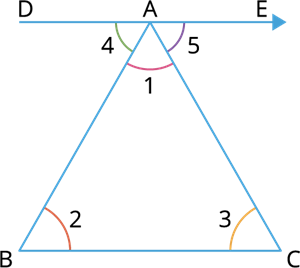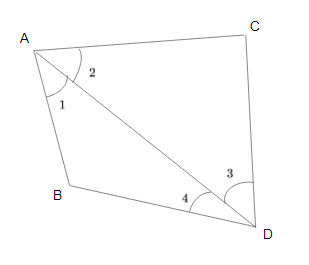PDF chapter test TRY NOW
Now recall the angle sum property of a triangle that we studied earlier.
The sum of the measure of three angles of a triangle is 180°.
Proof:
Consider a triangle ABC with interior angles measures ∠1, ∠2 and ∠3.
Draw a line DE parallel to BC.
Now the angle formed by the parallel line DE with the triangle ABC is ∠4 and ∠5.

Since DE is parallel to BC, using the alternate interior angle property ∠2 must equal to ∠4. Similarly, ∠3 must be equal to ∠5.
That is ∠2 =∠4 and ∠3=∠5. As DE is a straight line, ∠5 and ∠CAD are linear pairs (Pair of adjacent supplementary angles).
∠5 + ∠CAD = 180° .
That is, ∠5 + ∠1 + ∠4 = 180°.
Equivalently, ∠1 + ∠2 + ∠3 = 180°.
It states that the total measures of the three angles of a triangle is 180°.
Let's extend the angle sum property to the quadrilateral.
The sum of all the angles of a quadrilateral is 360°.
Proof:
Let ABCD be a quadrilateral.

Cut the quadrilateral into two triangles by drawing one of its diagonals AC.
It is obvious from the figure that ∠1+∠2 =∠A and ∠3+∠4 =∠C.
We know that the sum of all the angles of a triangle is 180°.
Consider the triangle ABC.
∠1 + ∠4 + ∠B =180°.
and ∠2 + ∠3 + ∠D =180°.
Adding the above equations will result as follows:
∠1 + ∠4 + ∠B + ∠2 + ∠3 + ∠D = 180° + 180°.
Arranging the angles in order becomes:
(∠1 + ∠2) + ∠B + (∠3 + ∠4) + ∠D = 360°.
Substitute the known values ∠1+∠2 =∠A and ∠3+∠4 =∠C,
∠A + ∠B + ∠C + ∠D = 360°.
Thus, the sum of the angles of a quadrilateral is 360°.
